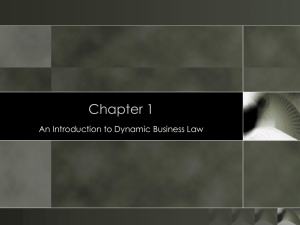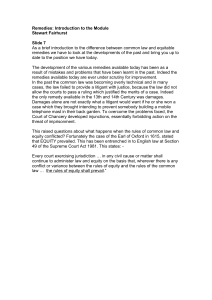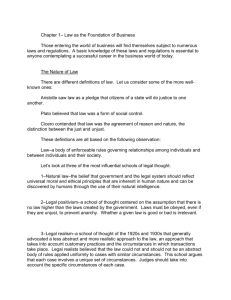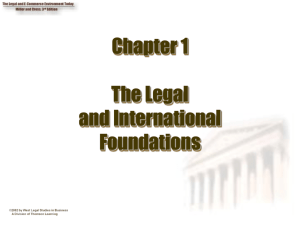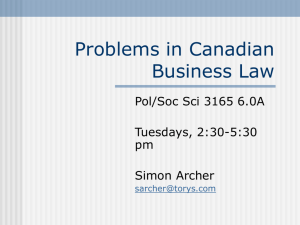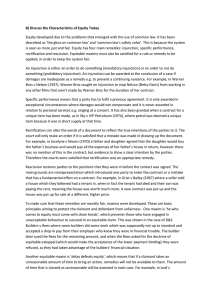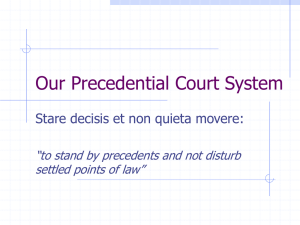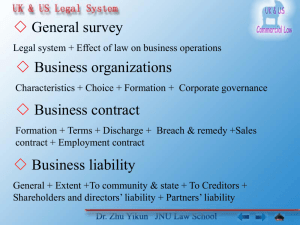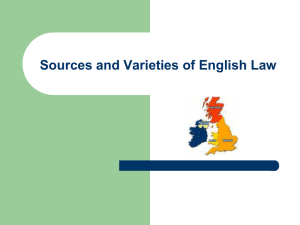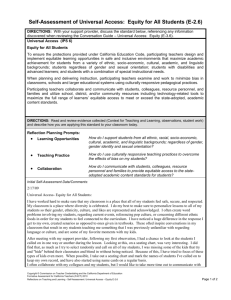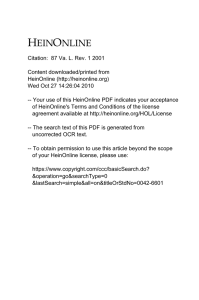§1: Schools of Jurisprudential Thought
advertisement
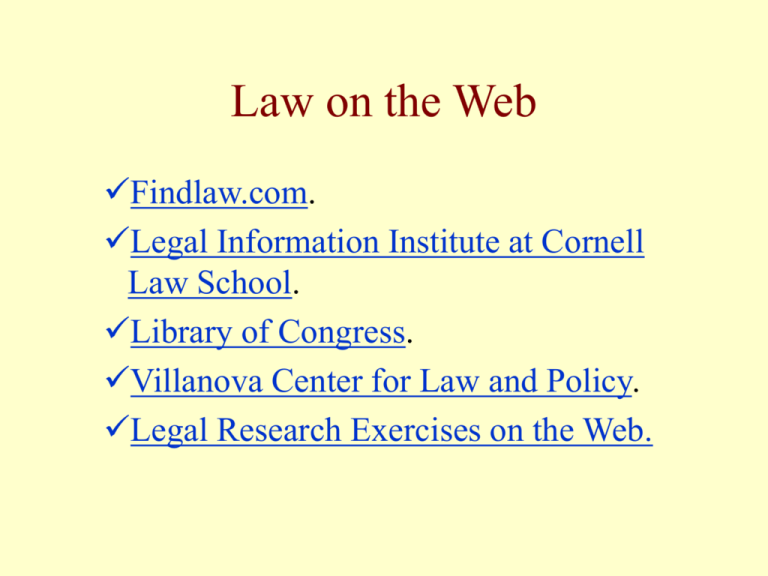
Law on the Web Findlaw.com. Legal Information Institute at Cornell Law School. Library of Congress. Villanova Center for Law and Policy. Legal Research Exercises on the Web. Chapter Outline Schools of Jurisprudential Thought Business Activities and the Legal Environment Sources of American Law The Common Law Tradition The Common Law Today Classifications of Law How to Find Primary Sources of Law How to Read and Understand Case Law Definition of Law Enforceable rules governing relationships among individuals (civil law) and between individuals and their society (criminal law). §1: Schools of Jurisprudential Thought • • • • Natural Law view. Positivist view. Historical view. Legal Realism view. Natural Law School • Assumes that law, rights and ethics are based on universal moral principals inherent in nature discoverable through the human reason. • The oldest view of jurisprudence dating back to Aristotle. • The Declaration assumes natural law, or what Jefferson called “the Laws of Nature.” The Positivist School • Law is the supreme will of the State that applies only to the citizens of that nation at that time. • Law, and therefore rights and ethics, are not universal. The morality of a law, or whether the law is “bad or good,” is irrelevant. The Historical School • Emphasizes the evolutionary process of law • Concentrates on the origins of the legal system • Law derives its legitimacy and authority from standards that have withstood the test of time • Follows decisions of earlier cases Legal Realism View of law started in 1920’s. Law must be viewed within the social context Judges should take economic and social realities into account. Sociological jurisprudence tends to be activistic, e.g., Civil Rights decisions. Do not feel bound by past decisions. §3: Sources of American Law • • • • U.S. and State Constitutions. Statutory Law—federal, state and local. Administrative regulations and decisions. Case Law and Common Law Doctrines. Hierarchy Among Sources of American Law Laws coming from various sources of American law are enforced according to the following hierarchy: 1. The US Constitution 2. Federal statutory law 3. State Constitutions 4. State statutory law 5. Local ordinances 6. Administrative rules 7. Common Law Sources of American Law Constitutional Law-Found in text and cases arising from federal and state constitutions-it is the supreme law of the land. Statutory Law -Laws enacted by federal and state legislatures. -Local ordinances -Uniform Laws (e.g., UCC). Sources of American Law Administrative Law -Rules, orders and decisions of administrative agencies, federal, state and local. -Administrative agencies can be independent regulatory agencies such ad the FDA -Agencies make rules, then investigate and enforce the rules in administrative hearings. Sources of American Law Case Law and Common Law Doctrines -Much of the common law is still used today. -Common law governs all areas not specifically covered by statutory or constitutional law. -Restatements of the law: modern compilations of common law principles found, e.g., in contracts, torts, property and agency. Stare Decisis Stare decisis is a Latin phrase meaning “to stand on decided cases.” – Makes the law stable and predictable. – Increases judicial efficiency by relieving courts of having to reinvent legal principles for each case brought before them. Stare Decisis and Precedent • Stare decisis is “judge made law” based on precedent. • Precedents are judicial decisions that give rise to legal principles that can be applied in future cases based upon similar facts. • Precedents and other forms of positive law, such as statutes, constitutions, and regulations, are referred to as binding authority and must be followed. Cases of “First Impression” In cases of “first impression” where there is no precedent, the court may refer to positive law, public policy, and widely held social values in order to craft the best new precedent. §4: The Common Law Tradition • American law is based largely on English Common Law which was based largely on traditions, social customs, rules, and cases developed over hundreds of years. Remedies: Law vs. equity • Remedy: means to enforce a right or compensate for injury to that right. • Remedy at Law: in king’s courts, remedies were restricted to damages in either money or property. • Equitable Remedy: based on justice and fair dealing-a chancery court does what is right. • Today, in most states, legal and equitable remedies are found in the same court. The Common Law Tradition [2] • At common law, there were two separate court systems with two different types of remedies: – COURTS OF LAW (monetary relief), and – COURTS OF EQUITY (non-monetary relief) based on “notions of justice and fair dealing.” Courts of Law • Also called “king’s courts” where judges were appointed by the king. • Remedies limited to those provided at law, i.e., land, chattel, money. • Judges resolved disputes by application of rules of law to the facts of the case before the court. Equitable Maxims • Whoever seeks equity must do equity; • Where the equities favor both parties, the dispute must be decided according to the law; • Whoever seeks equity must come to the court with “clean hands”; • Equitable relief will be awarded only when there is no adequate remedy at law; • Equity favors substance over form; and • Whoever seeks equity must pursue the vindication of their rights vigilantly or risk having their claims barred. §6: Classifications of Law Every type of law will be either: – Civil or Criminal, and either – Substantive or Procedural, and either – Public or Private. * Cyberlaw is law applied to internet transactions. Civil vs. Criminal • Civil law defines the rights between individuals or individuals and governments. • Criminal law defines an individual’s obligations to society as a whole. Substantive vs. Procedural • Substantive law defines or creates the rights and obligations of persons and governments. • Procedural law provides the steps one must follow in order to avail oneself of one’s legal rights or enforce another’s legal obligations. §8: Reading & Understanding Case Law Legal cases are identified by a “legal citation” (or a “cite”) as the example below: Toyota Motor Manufacturing, Kentucky, Inc., 534 U.S. 184 (2002). Title: First Party is Plaintiff, second party is Defendant. The parties are either italicized or underlined. Reading & Understanding Case Law [2] Legal cases are identified by a “legal citation” (or a “cite”) as the example below: Toyota Motor Manufacturing, Kentucky, Inc., 534 U.S. 184 (2002). This is a U.S. Supreme Court Case found in volume 534, page 184 of the U.S. Supreme Court reporter. Reading & Understanding Case Law [4] Legal cases are identified by a “legal citation” (or a “cite”) as the example below: Federal Express Corp. v. Federal Espresso, Inc., 201 F.3d 168 (2nd Cir. Read this Case at Findlaw.com 2000). by clicking on the hyperlink.
